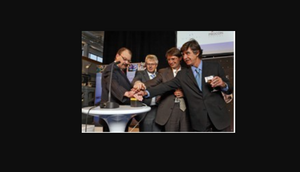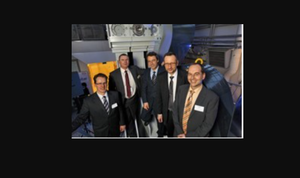DTP2—the best of two worlds
"We often talk about ITER in global terms, but we must not forget that it is the efforts of people on the ground that really push ITER forward," said the ITER Principal Deputy Director-General Norbert Holtkamp before he, together with Octavio Quintana Trias, Director of EURATOM, Didier Gambier, the Director of the European Domestic Agency, and Erkki Leppavuori, CEO of VTT Technical Research Centre of Finland pressed the button that set the first full-size prototype for ITER into motion.
These words were spoken on 29 January in the presence of more than 100 guests from the European fusion community, as the new ITER remote handling test facility, known as the Divertor Test Platform 2 (DTP2), was officially inaugurated in Tampere, Finland. The DTP2 facility is a required step in developing and testing the maintenance robots and remote handling operations necessary to the replacement of the ITER divertor. It was constructed over a period of four years at a cost of around EUR 4 million. Hardware for the project was sourced from all across Europe, including Spain, Luxembourg and Finland. Operation of the facility will be carried out under a joint venture between the VTT and the Technical University of Tampere (TUT). To date, the VTT has been mainly responsible for managing the installation of the facility hardware, while TUT efforts have been concentrated on developing the control software for the robotic devices and setting up the DTP2 control room infrastructure.
During the inauguration ceremony, the audience was addressed by the guests of honour mentioned above, as well as by Jouko Suokos, Executive Vice President of VTT, Seppo Karttunen, Head of the Research Unit EURATOM-Tekes and Riikka Heikinheimo, Director of Tekes, the Finnish Funding Agency for Technology and Innovation. Mr.Suokos explained how locating the DTP2 in Tampere allowed the facility to take advantage of the best of two worlds: the experience of the VTT—a well established and industrially focused research institute—and the theoretical strength and young talent provided by the university. Didier Gambier later reinforced this point by saying he hoped that research infrastructures across Europe would soon embrace the Finnish model of close co-operation between industry, research labs and universities which has been so well illustrated within the DTP2 project.



